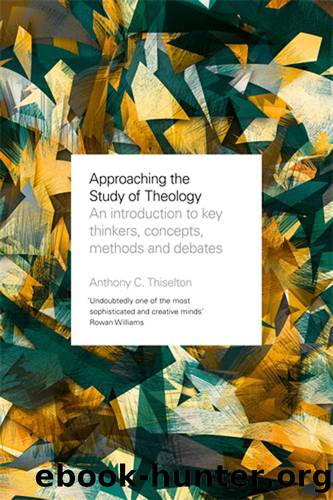Approaching the Study of Theology: An Introduction To Key Thinkers, Concepts, Methods And Debates by Anthony C. Thiselton

Author:Anthony C. Thiselton [Thiselton, Anthony C.]
Language: eng
Format: azw
Publisher: SPCK
Published: 2017-09-21T00:00:00+00:00
Liturgy, liturgical theology
In Greek, laos, âpeopleâ + ergon, âworkâ, form leitourgia, âpublic serviceâ). In the OT, worship often concerned the major festivals of Unleavened Bread, the Feast of Weeks or Harvest, and the Ingathering, and in addition the major festival of Passover. The Passover took place in the home, while the others were public festivals. Exodus 23.4â17 begins, âThree times in the year you shall hold a festival for me . . .â Exodus 34.18â23 repeats these instructions. Exodus 12.1â51; Deuteronomy 16.1â8; and 2 Kings 23.21â23 enjoin the festival of the Passover, as a reliving of Israelâs exodus and redemption from Egypt. 1 Kings 8 recounts worship in Solomonâs Temple. The Day of Atonement (Lev. 16) and the celebration of the Passover over time developed a fixed pattern of procedure, in effect, a liturgy.
In Leviticus the Day of Atonement begins with a warning not to approach the holy God unprepared, and much of the theology of Hebrews presupposes this. To approach God is not simply a human ârightâ. In the Day of Atonement (Heb., yÅm kippurîm) Aaron must first prepare a young bull to be sacrificed as a sin-offering for âhimself and for his houseâ (Lev. 16.6). Then he must prepare a ram to be sacrificed as a burnt offering. He is then to sacrifice two goats, one âfor the Lord and the other . . . for Azazelâ (16.8). The former becomes a second sin-offering for the people, while the latter becomes the scapegoat, which will be presented to the Lord, and sent away into the wilderness (16.9â10). The ceremony involves the purification of the sanctuary and the people (16.11â22). The Hebrew word kipper (16.11, 16â18) usually means to expiate or to atone, but in this context denotes to purify, involving the purification of the mercy-seat (16.13â14). The aim is to cover all the sins which may not have been cleansed or covered by other sacrifices. Hebrews 9 takes up the theme of the Day of Atonement, insisting that the Aaronic priesthood can never fully and completely atone for sin, whereas Christâs priesthood is finally effective, once for all (Gk, ephapax). In Judaism the Mishnah devotes a whole tractate to the Day of Atonement (m. YÅma).
The Passover Haggadah is detailed in Judaism, and the Lordâs Supper or Eucharist is modelled on it. Haggadah means narrative or narrative books in general, but also denotes specifically the Passover narrative in Exodus and in the contemporary liturgy of the Passover.157 This contains instructions for the composition of the Seder meal: the bitter herbs; the four cups; and the words of blessing, some of which bless God for the herbs and wine, akin to âsaying graceâ. It is important that the Haggadah and Mishnah state:
In every single generation it is a manâs duty to regard himself as if he had gone forth from Egypt, as it is written . . . âBecause of that which the Lord did unto me, when I came forth from out of Egyptâ . . . And he brought us out from thence.
Download
This site does not store any files on its server. We only index and link to content provided by other sites. Please contact the content providers to delete copyright contents if any and email us, we'll remove relevant links or contents immediately.
To Begin at the Beginning by Copenhaver Martin B.;(62)
Stay in the City by Gornik Mark R.;Wong Maria Liu;Keller Timothy;Acevedo Peter & Miriam Yvette;(62)
Liberal Arts for the Christian Life by Jeffry C. Davis(59)
Teaching the Faith, Forming the Faithful by Parrett Gary A.;Kang S. Steve;Packer J. I.;(56)
Processing the Plan of God Through Prayer by Mark Brazee(54)
Approaching the Study of Theology: An Introduction To Key Thinkers, Concepts, Methods And Debates by Anthony C. Thiselton(47)
Principles of Catholic Social Teaching by David A. Boileau(44)
Why Do We Suffer and Where Is God When We Do? by Valerie G. Rempel(43)
Two Tasks by Charles Malik(38)
Life Explore Soul by Sakulchai Sikitikul(33)
God's Greater Glory by Bruce A. Ware(22)
